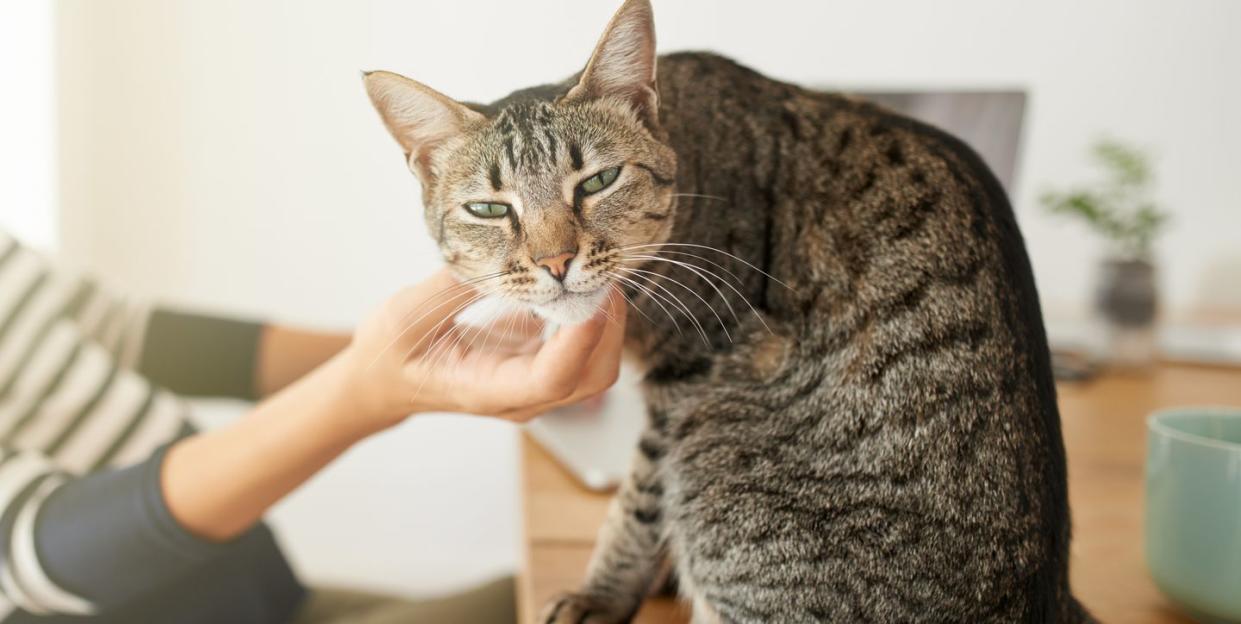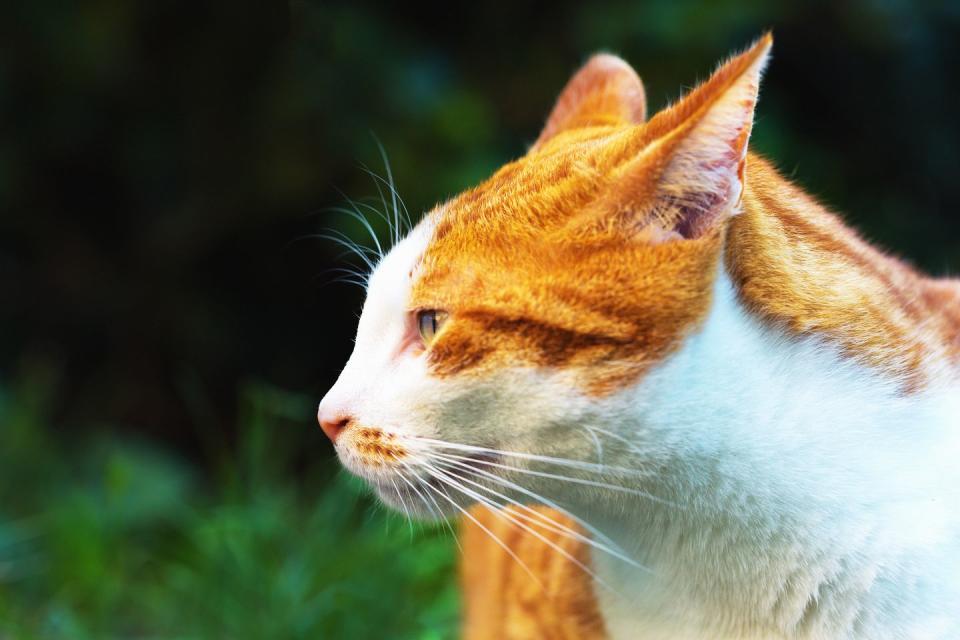A Guide To Learning What Your Cat Is Really Trying To Tell You

Your cat is definitely trying to tell you something if they're meowing every morning at 6 a.m. until you get up to feed them, or they're backed into a corner with their tail puffed up when your friend brings their dog over. But because cats are less domesticated than dogs, they're generally more complex, mysterious, and difficult for us to understand.
Cats are just generally "more" than dogs in a lot of ways, and that's part of what makes cat people love them so much. But if you haven't grown up around cats, you might have some trouble speaking their language. After all, cats communicate with us in a wide variety of ways. Here's how to interpret cat language, according to two veterinarians.
You can learn a lot from their body language and sounds
Sean McCormack, head veterinarian at subscription dog food brand Tails and author of The Happy Dog Cookbook, tells Woman's Day that a cat's main vocalization is the classic "meow," which is reserved just for humans. "It’s usually a generic attention seeking cry," McCormack said. A meow usually means something like “Feed me!," "Stroke me!," or "Notice me!”

When it comes to their body language, cats will rub themselves against us, often with their head, neck, and chin, "to bond with us or perhaps even mark us as their own," McCormack said. "Cats produce a pheromone called Feline Facial Fraction F3 from glands around the chin and neck, and it’s calming to them to have this in their environment. Hence their rubbing on surroundings, including furniture and people."
Dr. Caroline Wilde, a veterinarian with Trupanion, which provides medical insurance for pets, tells Woman's Day that when you're looking at a cat's postural cues, you should look at the cat's whole body. "Don't just pay attention to the eyes or the position of the head, but look at the whole position of the cat as a whole," she said. "When a cat is friendly and relaxed, it's more likely to have a relaxed posture, whereas a cat that's fearful or anxious is more likely to crouch and lean back."
Here's what the heck is up with purring
It's not hard to figure out that purring is seen as a sign of contentment and happiness in cats. Wilde noted that researchers have done studies to figure out what exactly purring is and how cats do it and it's still not totally clear. "They do know that it's not specific to one part of the cat body, but it is caused by vibrations in the throat area," she said. It's less of a vocal cue, and more a sound made by the vibrations of the cat's throat.
Usually we associate it with cats being happy, content, or relaxed, but cats also use purring to self-sooth, Wilde said. "I've had cats that are really scared purr while they're sitting on the exam table, or even cats that are really sick will be purring."

McCormack also noted that cats will sometimes purr when they're in pain. "It’s thought to be a natural endorphin release for cats so they do often do it when they are experiencing pleasure," he said. "Overall, it’s done for a soothing, comforting effect, which is why mother cats will do it when they are suckling or grooming their kittens. If they are hurt and purr, perhaps the feel good effect helps numb that a little."
Even their eye movements have meaning
My favorite cat movement is the slow blink, where they sort of seem to hold their eyes closed for a moment before opening them a little again, and apparently even that can convey some info about their mood. "In general, when a cat is relaxed, they tend to sit with their eyes sort of at half mast," Wilde said. Whereas eye contact between humans can forge a stronger connection or tell someone you're paying attention to them, for animals prolonged eye contact is a sign of aggression. "When a cat does the slow blink, that's actually them trying to communicate that they're not being aggressive," Wilde said. "It breaks up an aggressive stare."
The slow blink is one of the more subtle non-verbal communications that cats display with their eyes, McCormack said. "The intense stare with dilated pupils that one cat will direct at a stranger in its territory is a direct challenge for the other cat to back off," he said. "The slow, contented blink is an appeasement sign that a cat is comfortable in the presence of another cat or person, and a harmonious coexistence is on the cards." Your cat is trying to tell you "I’m relaxed and happy in your presence," he said.
Yes, they knead you or "make bread" because they love you
The kneading or bread-making motions cats do when they lay on a person or on something soft is related to the mother and kitten bond, according to McCormack. "Kittens knead Mum’s belly as they are suckling to stimulate happy hormones like oxytocin and prolactin, and as a result stimulate more milk to be produced," he said. The behavior often continues into adulthood because it comforts the cat and helps them maintain important bonds.
These signs of distress or fear could be big red flags
Cat people should watch out for certain signs of distress, because they could be indicative of an illness or something else that's really bothering your cat. When a cat isn't feeling well they won't carry out their normal behaviors, Wilde said. "If a cat generally likes to groom, if they're not doing that grooming behavior, then that certainly can be an indication that they're not feeling well," she said. "Any deviation from normal can be a sign that things aren't fitting quite right with the cat."

If a cat is scared or stressed, McCormack said one of the first things they'll do is hide, "which often happens when there is a change in the environment or a move to an unfamiliar one." They also might raise the hair on their backs and tails to make themselves look bigger if they feel threatened or scared, and they might yowl, growl, or hiss.
Wilde said it's also important to pay attention to a cat's ear position. If its ears are to the side or flat back, that's a sign that they're feeling afraid or anxious. If they're crouched back or their eyes are wide and their pupils are dilated, that can also indicated that they're scared.
"It's just really important to be careful because cats do try to communicate when they're scared, and if we can pick up on those cues, then we can hopefully avoid injury," Wilde said, noting that she has seen some injuries from cats lashing out when they're scared. "It's not anything to ever take lightly," she said, and cat owners should do what they can to reduce a cat's stress or fear in a scary situation, or create a space where they can retreat to or feel protected.
They'll tell you when they're happy, too
In addition to purring, cats will tell you they're happy by being playful or engaging with you, McCormack said. They'll also rub on the furniture, have a good appetite, and will feel confident enough "to be out in the open in all areas of the home."
Wilde said that rubbing up against something is one of the strongest signs that a cat is happy with you or wants your attention. "They can do that to just spread their scent, but also headbutting, rubbing against a person or another cat, that's a cue that they're happily interacting with that person or that other animal," she said. "My cat will actually do that to my pit bull. It's the cutest thing."
So basically, if your cat is headbutting you or your other animals, you're doing something right.
You Might Also Like


